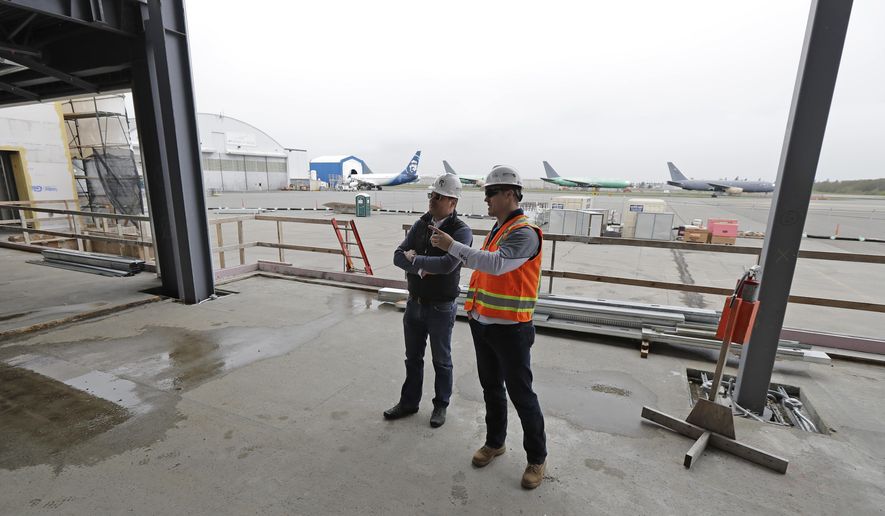EVERETT, Wash. (AP) - It’s not uncommon to see brand new commercial jets flying in and out of Paine Field, just north of Seattle, defying rain and low visibility that define the region. That’s because the airport with two runways has for decades served as home to Boeing assembly lines, rolling out models such as the 777 for test flights over the Pacific Ocean.
Now an entrepreneur is getting a chance to build the airport’s first passenger terminal, betting travelers in Seattle’s rapidly-expanding suburbs will use it for short-haul trips instead of fighting traffic and long lines at SeaTac International, one of the country’s busiest hubs.
Brett Smith’s company is investing about $40 million to build the terminal. In the process, he wants to increase U.S. acceptance of a global trend: Putting commercial airport terminals in the hands of private companies instead of the government.
Smith is the founder and chief executive officer of Propeller Investments LLC., which secured a 50-year agreement with Snohomish County three years ago through a local subsidiary to build and operate the terminal in Everett, Washington. Operations are due to start in the fall, with announcements already made from Alaska Airlines, Southwest Airlines and United Airlines for up to 24 flights per day.
The deal stands out for U.S. airports because it’s structured as a public-private partnership, a model that divides the responsibilities of owning and operating public assets between governments and the private sector. It’s also notable because Propeller has no experience in building or operating airport terminals.
The project contrasts with about 500 commercial airports across the U.S., where local governments own and operate most of the facilities. Those airports have relied on decades of federal funding and passenger fees to help finance infrastructure improvements. But traditional funding sources have remained flat since the turn of the century, failing to keep up with increased air travel demand.
Airport privatization proponents point to efficiencies and variety of passenger amenities like stores and restaurants found in major European hubs such as London’s Heathrow and Frankfurt Airport, both of which are run by companies and rated among the 10 best airports in 2018 by Skytrax, an independent agency that ranks airports and airlines based on traveler reviews. No U.S. airports made the list this year.
“Public-private partnerships in the airport realm were almost unheard of 18 months ago. Now barely a day goes by where I don’t get a call asking about them,” said Peter Kirsch, a Denver-based partner at Kaplan Kirsch Rockwell, the law firm that represented Snohomish County during its negotiations with Propeller. The firm also represented Propeller during its talks with the airlines. “It’s the future of airport development.”
Only a handful of U.S. airports have adopted any form of privatization. Southwest Airlines financed and built a five-gate terminal at Houston’s Hobby Airport that opened in 2015. Denver signed an agreement last year to allow a group of companies led by Madrid-based Ferrovial, the company that built and operates two terminals at Heathrow, to renovate Jeppesen Terminal at Denver International Airport and operate concessions.
Almost half of airports in the European Union are either “fully” or “partially” private, according to a study by Airports Council International, an advocacy group made up of airport operators. It estimates U.S. airports will need to implement $100 billion of infrastructure works by 2021 to accommodate passenger and cargo volume growth.
“There’s an old adage that says ’necessity is the mother of invention,’” said Patti Clark, who used to manage Valdosta Regional Airport in Valdosta, Georgia, and now teaches airport sustainability and environmental management at Embry Riddle Aeronautical University in Daytona Beach, Fla. “What we have is an aging infrastructure of airports in the U.S. Partnerships with the private sector help improve facilities and competitiveness.”
But those projects carry the risks of being dependent on the airlines, which are already grappling with thin profit margins. Airlines reducing or cancelling their operations in a particular terminal can leave “gaping holes” in operator revenues, she said.
Paine Field handles about 300 flights per day. In 2015, the Snohomish County Council voted to lease 10.5 acres (4.2 hectares), or less than 1 percent of the airport’s total area, to Propeller for 30 years and give the company two additional 10-year extension options.
It marks the first test for Smith, who tried to secure deals to establish commercial operations in Georgia’s Gwinnett and Paulding Counties. He was unsuccessful due to opposition from the communities and Delta Airlines, which dominates traffic at nearby Hartsfield-Jackson Airport in Atlanta.
“To me this is an honor, so it has to go well,” said Smith, who relocated to Seattle from New York to oversee construction. “We have to be able to show that with privatization you get a really good product.”
Propeller sold $50 million of bonds in February to finance the project, paying investors about double the interest rate they would earn on similar U.S. Treasurys, according to data compiled by The Associated Press. The company doesn’t have a credit rating.
“We’re trying to really grow the job base here in Snohomish County, and having that direct access for businesses, I think it’ll be a boon,” County Executive Dave Somers said.
The company’s lack of a track record isn’t a concern because “it’s a land lease. If they can pull it off, then they can pull it off. If they don’t pull it off, we haven’t lost anything.”
____
AP Business Writer Stan Choe contributed to this story.




Please read our comment policy before commenting.